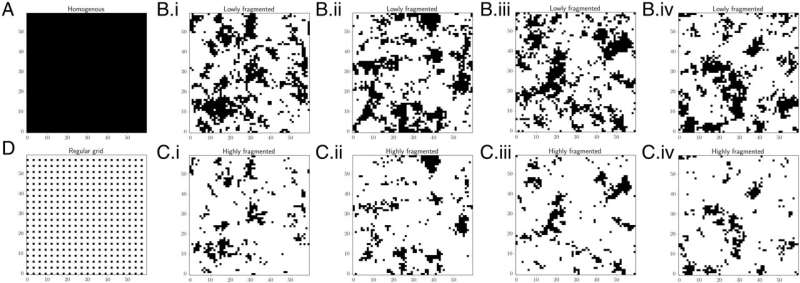This article has been reviewed according to Science X's editorial process and policies. Editors have highlighted the following attributes while ensuring the content's credibility:
fact-checked
peer-reviewed publication
trusted source
proofread
Landscape fragmentation overturns classical metapopulation thinking

When an ecosystem faces the challenge of habitat fragmentation, ecologists and conservation biologists traditionally have encouraged population dispersal to give species the best overall chance of survival. However, new research by Yun Tao, assistant research scientist in the University of Georgia's Institute of Bioinformatics, suggests the opposite approach may be the way to go.
These findings have an important impact on strategies for biological conservation as more and more ecosystems are threatened by fragmentation caused by human development and other phenomena.
"Rather than promoting dispersal, we're saying maybe the opposite strategy could be more effective," Tao said, pushing back against a long-held conservation strategy. "Perhaps, in many instances, the key is insulation."
This paper, titled "Landscape fragmentation overturns classical and metapopulation thinking," was published in Proceedings of the National Academy of Sciences.
The world is connected by population hubs; humans concentrate in urban areas, while animals and plants also concentrate around rich habitats. There is significant dispersal, a kind of directionless movement, occurring among these clusters. Fragmentation plays a key role, as removing a habitat typically results in two things: limiting the space in which a species can live and reproduce while also isolating the remaining populations, generally harmful to biodiversity.
The challenge, Tao said, is evaluating how well a species performs under habitat fragmentation —whether the total tally of the species, summed across many populations (metapopulation), is growing or diminishing, how long can these populations survive, and whether they are vulnerable to mass extinction. To do so, one must understand what happens within and across different hubs and how the fate of all populations are connected by dispersal.
Past population studies indicate that when species can disperse farther, they have a better chance of finding new habitats where they can thrive. Others, lacking this ability, can get stuck. The issue in trying to understand the effects of habitat fragmentation in past models, in an effort to simplify analysis, have often oversimplified the geometry of habitat spaces.
"To really understand what happens to ecosystems in the face of habitat fragmentation, we need to model metapopulation on a spatially realistic landscape that contains geometrically realistic habitats," he said. "That means recognizing that population hubs can occupy habitats of any size and shape."
Doing so using advanced modeling techniques yielded surprising results.
While in some cases, traditional ideas of conservational biology remained true, Tao and his team found the opposite in others.
"Historically, it's assumed that species struggle to survive in unstable environments," Tao said. "But we found that under fragmentation, some species can actually benefit from some form of instability."
In addition, while short-ranging species—those that cannot disperse very far—are more prone to sudden mass extinction in the early stages of fragmentation, Tao said, species that disperse over long distances are at the highest risk of extinction as fragmentation gets worse over time.
"So, if one unknowingly compares species performance at different stages of fragmentation, they may find contradiction in the results," Tao said.
Tao highlighted the importance of interdisciplinary thinking, given its implications for effective conservation strategies.
"This reassessment of long-established ideas about metapopulation becomes possible through the merging of population ecology and landscape ecology—a dispersal across disciplines" Tao said. "Hopefully this work will pave the way for more in-depth studies in the future."
Tao began working on the project as a graduate student. He received a National Science Foundation fellowship that allowed him to spend nine months in Finland alongside Ilkka Hanski, the "father of metapopulation theory."
"After Hanski passed away, it took us a few years to regroup and understand where the field is going, where human knowledge in regard to the subject is heading, and sort of reframe our analysis to the most urgent need right now in terms of climate change and habitat loss," he said.
More information: Yun Tao et al, Landscape fragmentation overturns classical metapopulation thinking, Proceedings of the National Academy of Sciences (2024). DOI: 10.1073/pnas.2303846121
Journal information: Proceedings of the National Academy of Sciences
Provided by University of Georgia



















